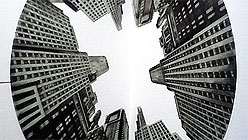On Thursday, May 21, we took a field trip to visit the 2012 U.C. Berkeley and Stanford MFA exhibitions. Both schools featured relatively small graduating classes (7 students at Berkeley; 5 at Stanford) in comparison to the mondo exhibitions at other Bay Area art schools (see reviews of this year’s San Francisco Art Institute, California College of the Arts and Mills College shows). Perhaps this relative sparseness is what contributed to the quiet we found at each exhibition. Works in both shows lacked color and were unassuming even when they took up a good deal of space. What these shows had — that other locals lacked — was breathing room, which may have created the impression that each artist was turned inward, inhabiting his or her own corner without engaging one another and with little need for the viewer.

Installation at the Berkeley Art Museum
This feeling may have come in part from the exhibitions’ settings; Stanford’s students take over the very staid Thomas Welton Stanford Art Gallery, while Berkeley’s graduates were slipped into one of the Berkeley Art Museum’s bays, between an exhibition of Himalayan artifacts and an overview of California conceptual art from the early 1970s. In the bottom floor of the B.A.M., panels were being installed for the upcoming Barry McGee retrospective. What we love about the Berkeley Art Museum, its severe modernist concrete structure, may also have been the thing that was working against the students there. The architecture overwhelms with its concrete coldness and the art has to work hard to be heard. But Berkeley’s students seemed content to be tucked into their corner. Their gestures were simple and easily overwhelmed, which was touching — a quiet space separated from a loud and overwhelming world.
Kari Marboe’s one image (it really is a bold move to end your college career by presenting just one thing) reinforced this idea. Her piece was a large, glossy photograph of a building topped by a marquee that read, “I love you is such an enormous gift that I need to house it here for a week so that we can use the apartment.” It was a sweet gesture that could be appreciated by almost anyone who has ever been overwhelmed by a love that is too big to contain.

Amy Rathbone, This, That and Other, 2012; courtesy of the artist.
Amy Rathbone’s hanging plastic bag sculptures and Rodrigo Ojeda-Beck’s perplexing home videos sat in one gallery, along with Brett Walker’s cheeky installation about… himself? photography? The work is a series of 47 photographs of various shapes, sizes and orientations spread out across two gallery walls. It reminded us of a fold-out double-album record sleeve depicting the touring exploits of a seventies rock band à la The Allmann Brothers or better yet — given the subjects’ propensity for sporting unusual facial hair, a growing concern among the young, white and “indie” — ZZ Top.









